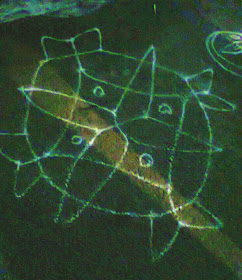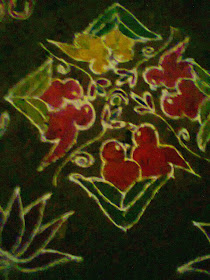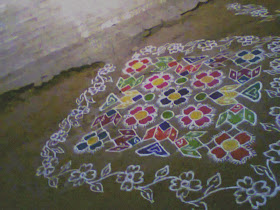Pattachitra is a general
term for traditional scroll painting in India, especially in Odisha and
West Bengal states.The Sanskrit pata means cloth, chitra means painting.Patachitra is the painting usually made on tasar silk cloth. Sometimes it
is also made by gluing layers of old cotton cloth with tamarind glue and
chalk to create a leather like surface.The history of 'patachitra' or scroll painting in
Bengal goes back to more than two thousand years. Rural bards and
story-tellers in earlier times would use these scrolls which had pictures depicting various events and themes
of the stories they would tell.
పాటచిత్ర
పెయింటింగ్ లు ఒరిస్సా రాష్ట్రములో మరియు పశ్చిమ బెంగాల్ రాష్ట్రములో చిత్రిస్తారు.
2 రాష్ట్రములలోని పాటచిత్ర పెయింటింగ్ ల యొక్క శైలి విభిన్నమైయినది. దేనికవే ప్రత్యకమైనవి.
పశ్చిమ బెంగాల్ రాష్ట్రములోని పశ్చిమ మిడ్నాపూర్ జిల్లాలో చిత్రించే పాటచిత్ర పెయింటింగ్ లకి ఆ ప్రాంతము పేరు అయిన మిడ్నాపూర్
పాటచిత్ర పెయింటింగ్స్ అనే పేరు వచ్చింది. ఈ మిడ్నాపూర్ పాటచిత్ర పెయింటింగ్ లకు 2000 సంవత్సరముల చరిత్ర కలదు. ఈ చిత్రకారులు
ప్రకృతిలో దొరికే సహజసిద్ధమైన వనమూలికలు మొదలగునవి ఈ చిత్రములు గీయడానికి వాడతారు. వీరు చిత్రించే పాటచిత్ర పైంటింగ్స్ చాలా విలక్షణముగా మరియు ఏ ప్రాంతములో లోని ఒక ప్రత్యేక శైలి లో ఉంటాయి .వీరు చిత్రించే చిత్రములతో వీరిలో కొంతమంది కధలు చెబుతారు. భారత దేశములో అనాది కాలము నుంచి చిత్రములతో కధలు చెప్పే సంప్రదాయము ఉన్నది.
ఈ మిడ్నాపూర్ పాటచిత్ర పెయింటింగ్స్ చిత్రించే కళాకారులు అందరి పేరులోను చిత్రకార్ అనే పేరు వారి పేరుతో పాటు కలిగి ఉంటారు. నేను సేకరించిన ఈ మిడ్నాపూర్ పాటచిత్ర పెయింటింగ్స్ ని బహదూర్ చిత్రాకార్ మరియు మరికొంతమంది దగ్గర తీసుకున్నాను.
ఈ మిడ్నాపూర్ పాటచిత్ర పెయింటింగ్స్ చిత్రించే కళాకారులు అందరి పేరులోను చిత్రకార్ అనే పేరు వారి పేరుతో పాటు కలిగి ఉంటారు. నేను సేకరించిన ఈ మిడ్నాపూర్ పాటచిత్ర పెయింటింగ్స్ ని బహదూర్ చిత్రాకార్ మరియు మరికొంతమంది దగ్గర తీసుకున్నాను.
The traditional colors used in the patachitra art are red, ochre, indigo,
green, black and white all obtained from the natural sources like
Hingula, Ramaraja, Haritala, lamp black, and shells.The brushes are crude
made of the hair of domestic animals. Usually the squirrel hairbrushes
are not used but the fine brushes made from the hairs of a mongoose or
rat, or the coarser brushes made from the hair of a buffalo neck. In the
past, artists also used kiya plants for drawing thick lines.The adhesive
if used any for these paintings are made in tamarind seeds. The tamarind
seed powder is soaked in water overnight and then boiled to provide it a
gummy consistency.
First the outlines are made using red and yellow colors and then other
colors. The figures are then color filled using the same colors. The
background color is red and is filled prior to other colors. The paintings
concentrate on sculpture like figures of simple shapes and monotonous postures
and expression. The final step is giving a protective coating. The cloth
is given a lacquer coating to protect from the effects of nature and give
a glazed varnished look. It is followed, by painting the background in
red, also known as pahili ranga bhara or first coloring. In the
subsequent stage, the artist colors the figures, applies the red
ornaments and black details and completes the border decoration.
The central colors used in Patachitra are red, brick red, yellow, white
and lamp black. The painter employs the various kinds of brushes. Sometimes,
artist adds rice powder to the mixture to give a stiffer feel to the
canvas. The painting is done on cloth which the artists prepare
themselves by coating it with a mixture of chalk and and gum made from
tamarind seeds to give the surface a kind of a leathery finish on which
the artists paint with earth and stone colors.
History of Midnapore Patachitra Paintings
Patachitra, an ancient folk art of Bengal , is appreciated by art lovers all over the world for its effortless style of drawings, colours, lines and space usage. The world Pata derived from the Sanskrit word Patta means cloth. The painters are called Patuas. Patuas do not just paint, they also sing as they unfurl the painting scroll to show it to the audience. These songs are known as Pater Gaan. The songs are of wide variety ranging from traditional mythological tales and tribal rituals to stories based on modern Indian history. Patuas generally use natural colours, which they procure from various trees, leaves, flowers and clays.
Patachitra has been mentioned in Puranas, Epics, Ancient Literatures and Historical Descriptions. The style of painting is similar to the cave paintings of Mohenjodaro, Harappa and Ajanta . ‘Patuas' and ‘Chitrakars' have been referred to in literary works dating back to more then 2500 years. Some researchers opine that ‘Patashilpa' was originally an art from of the Santhals (tribal community). It was popular among Hindu tribes like Santhals, Hos, Munda, Juangs and Kherias who painted ‘Patachitras' depicting the birth of their first ancestors Pilchu Haram and Pilchu Burhi; how they had seven sons and seven daughters and how these seven brothers were married to their sisters. With the growing influence of Buddhism, the Patuas embraced the faith. Buddhist kings and monks made extensive use of scroll paintings to preach Buddhism and during this time Patachitra probably spread to Bali, Java, Sri-Lanka , Malaysia and Tibet . With Muslim invasions, Islam spread and the Chitrakars became followers of Islam.
Since 2004, banglanatak dot com is working with 230 Patuas to rejuvenate the dying art form. The Patuas have learned to make diverse products using their painting skills. They are also using their art from as tool for social communication. The art form has become a means of livelihood. This has led to reduction of poverty and most importantly empowerment of the women in the community. The Eastern Zonal Cultural Centre (with support of Ministry of Rural Development) supported capacity building and promotional activities during 2005-2009. Today young people are learning the art from their living Gurus. Project Ethno-magic Going Global (EGG), an ongoing initiative by banglanatak dot com supported by the European Union has facilitated interaction between Patuas and Contemporary painters and new media artists from Europe . Health insurance has been provided to the artists and their families. Resource centre is being developed at Pingla.
Every year there will be Pata Chitra festival celebrated in the Naya village of Pingla block of Midnapore district. People from several corners across the globe now visited the festival every year and enjoyed very much and learned about Midnapore Patachitra paintings.
Recently i got 2 different Midnapore Patachitra paintings from Midnapore. They are Ramayana scenes and Goddess Durga paintings.
Below is the photo of a artist who draw similar like above Goddess Durga patachitra painting. He draw this painting during Patachitra festival.
Today i.e. on 1st February i got 3 other Midnapore patachitra paintings from Mr.Gurupada Chitrakar of Naya Pingla, Midnapore. They are Fishes taking food, Hungry Lion Hunting Deers and Tribal Festival paintings.
This is Tribal Festival Midnapore Patachitra painting which is in my collection.
This is Tribal Festival Midnapore Patachitra painting which is in my collection.
These are 2 different photos of similar like above tribal festival painting drawn by children during the Patachitra festival.
This is similar like Angry Lion painting drawn by a artist during Patachitra festival.
This is fishes taking food midnapore patachitra painting which is in my collection.
Recently on 30th November 2014 i am presented my Third Seminar on Indian Heritage and Culture to younger generation children. In this seminar i am sharing my original paintings collections of Midnapore Patachitra paintings, Madhubani paintings, Cherial Paintings, Warli Paintings and Kalamkari paintings.
Many younger children came to my presentation on that day and clarified their doubts. Please look into my 3rd Seminar on Indian Heritage and Culture message.
http://indian-heritage-and-culture.blogspot.in/2014/12/my-third-seminar-on-indian-heritage-and.html




























































































